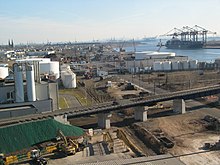Chemical Coast
The Chemical Coast is a section of Union and Middlesex counties in New Jersey located along the shores of the Arthur Kill, across from Staten Island, New York.
The name is taken from the Conrail Chemical Coast Line, an important component in the ExpressRail system serving marine terminals in the Port of New York and New Jersey.
In 1907, John D. Rockefeller, the founder of the Standard Oil company, acquired several hundred acres of the former Morse family estate between Linden and Elizabeth for what would become the Bayway Refinery.
[7] The Shell Oil Company opened a terminal facility on a 145-acre (59 ha) former Boynton farm property along Arbor Street in Sewaren in 1928.
[8] Emissions from the area's chemical plants have been blamed for some serious health problems that have been observed among residents of neighborhoods on Staten Island situated directly across the Arthur Kill, specifically an elevated rate of cancer found to exist among long-time denizens of Travis.
Plans are to reactivate the North Shore of the Staten Island Railway to allow freight shipments to and from the recently revamped Howland Hook Marine Terminal.
Some of these latter proposals would run passenger trains to Cranford Junction, while others call for a western terminus at either the former Arlington or Port Ivory stations on Staten Island.


